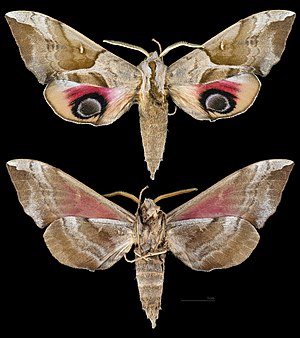Smerinthus planus
| Smerinthus planus | ||||||||||||
|---|---|---|---|---|---|---|---|---|---|---|---|---|

Smerinthus planus |
||||||||||||
| Systematics | ||||||||||||
|
||||||||||||
| Scientific name | ||||||||||||
| Smerinthus planus | ||||||||||||
| Walker , 1856 |
Smerinthus planus is a butterfly ( moth ) from the family of moth (Sphingidae).
features
The moths reach a wingspan of 70 to 100 millimeters. They have a resemblance to a large evening peacock butterfly ( Smerinthus ocellatus ) and, like this one, which is drawn in light and dark brown and gray tones, the upper sides of the forewings and the hind wings are provided with conspicuous eyespots . The spring generation adults are the smallest, those that hatch in September or October are significantly larger. If the doll exposed during the development cold, which imagines colored with more gray shares. In drought and warmer temperatures, the animals tend to be paler and more brown.
The caterpillars reach a body length of 70 to 90 millimeters. They appear in a bluish-green and an apple-green color variant. The young caterpillars are initially about six millimeters long, have a pale, whitish-green color and a red-black anal horn . In the second caterpillar stage, pale streaks appear on the sides of the body and the head becomes pointed at the top. The adult caterpillars look very similar to those of the evening peacock and behave that way. However, the tubercles on her body are coarser, the white stripes on the sides of the body are wider, and the anal horn is less blue in color.
The pupa is 35 to 48 millimeters long and indistinguishable from that of the evening peacock.
Occurrence
Smerinthus planus is distributed from northern Xinjiang through northern China, Mongolia and southeastern Siberia to the Russian Far East and Japan. In the south, it spreads over Korea and Taiwan to Hainan , Yunnan and the east of Tibet . The occurrence of the species on the Chinese-Kazakh border (Kazakh district Ili ) extends the range of the East Palearctic species significantly to the west. The cause is probably due to the intensive planting of poplars and willows in northern China, which enable the species to expand its range, as has also happened with Callambulyx tatarinovii .
The species inhabits agricultural areas and deciduous forests along valleys.
Way of life
The moths show the eyespots of their hind wings for defense . They do this more strongly than evening peacock eyes. They can also fall to the ground more quickly in the event of a fault. The moths hatch shortly after dusk. The females lure the males with pheromones in a short period of time at midnight. The pairing is relatively short and only lasts a few hours. Usually the couple split up before dawn. The females often lay their eggs in the same night, right after mating.
Flight and caterpillar times
The species is believed to be bivoltine in western China . Further east in China, depending on altitude and weather, two to four generations occur each year, flying between April and September. Two generations are the norm in Beijing and Ningxia , three in southern Shaanxi and four in Jiangsu and Jianxi . In the Russian Far East, the species occurs from late May to early August. In Korea, the species flies from the beginning of May to the end of July, with individual specimens being found in August.
Food of the caterpillars
The caterpillars feed on most species of poplar ( Populus ) and willow ( Salix ), with the former being preferred. They are also found in apples ( Malus ) and Prunus . A record of the species on elms by Wang in 1988 is probably an error.
development
The very shiny, pale green, oval eggs measure 1.9 by 1.6 millimeters. They become grayish before the caterpillars hatch. The females place them individually or in pairs on the underside of the leaves of the host plants at a height of no more than two meters above the ground. Initially, the caterpillars cling firmly to the leaf vein on the underside of a leaf with all legs, later they sit quietly in the typical "sphinx position", in which they cling to the three rear pairs of belly legs . The animals are perfectly camouflaged due to their coloring, which balances out the body shadow.
Specialized enemies
The caterpillars of the parasitoid parasitic wasps Callajoppa lutoria and cephalotes Netelia and by the braconids Aleiodes praetor , Cotesia planus , Cotesia suzumei and Microplitis ocellatae affected. As with the evening peacock butterfly, large losses due to the parasitoids occur in a colony during caterpillar development.
Crosses with the evening peacock butterfly
In Europe, the females of this species attract males of the evening peacock and can use them to produce fertile eggs, from which caterpillars also hatch. However, moths result only from male pupae. These males are not attracted to the females of Smerinthus planus . It is unknown whether they are attracted to the females of the evening peacock.
supporting documents
Individual evidence
- ↑ a b c d e f g h i j Sphingidae of the Western Palaearctic. AR Pittaway, accessed December 29, 2012 .
- ↑ a b c d e Sphingidae of the Eastern Palaearctic. AR Pittaway, accessed December 29, 2012 .
literature
- Ian J. Kitching, Jean-Marie Cadiou: Hawkmoths of the World. An Annotated and Illustrated Revisionary Checklist (Lepidoptera: Sphingidae). Cornell University Press, New York 2000, ISBN 0-801-43734-2